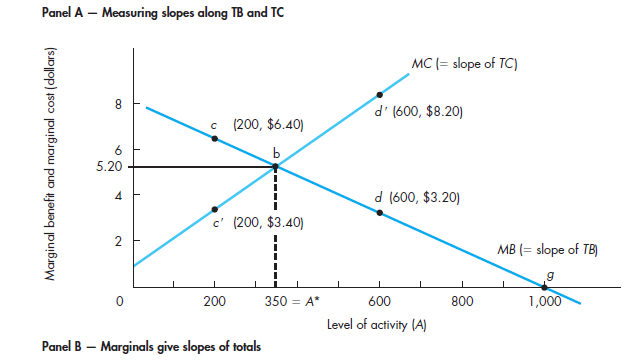Refer to Figure 3.2 and answer the following questions:a. At 600 units of activity, marginal benefit is___________
Question:
Refer to Figure 3.2 and answer the following questions:a. At 600 units of activity, marginal benefit is___________ (rising, constant, positive, negative) because the tangent line at D is sloping___________ (downward, upward).b. The marginal benefit of the 600th unit of activity is $___________. Explain how this value of marginal benefit can be computed.c. At 600 units of activity, decreasing the activity by one unit causes total benefit to___________ (increase, decrease) by $___________. At point D, total benefit changes at a rate times___________ as much as activity changes, and TB and A are moving in the (same, opposite) direction, which means TB and A are ___________(directly, inversely) related.d. At 1,000 units of activity, marginal benefit is ___________. Why?e. The marginal cost of the 600th unit of activity is $___________. Explain how this value of marginal cost can be computed.
f. At 600 units of activity, decreasing the activity by one unit causes total cost to___________ (increase, decrease) by $___________. At point D?, total cost changes at a rate___________ times as much as activity changes, and TC and A are moving in the___________ (same, opposite) direction, which means TC and A are ___________(directly, inversely) related.g. Visually, the tangent line at point D appears to be ___________(flatter, steeper) than the tangent line at point D?, which means that (NB, TB, TC, MB, MC) is larger than ___________(NB, TB, TC, MB, MC).h. Because point D lies above point D?,___________ (NB, TB, TC, MB, MC) is larger than ___________(NB, TB, TC, MB, MC), which means that ___________(NB, TB, TC, MB, MC) is ___________(rising, falling, constant, positive, negative, zero).
Figure 3.2


Step by Step Answer:

Managerial Economics Foundations of Business Analysis and Strategy
ISBN: 978-0078021909
12th edition
Authors: Christopher Thomas, S. Charles Maurice





